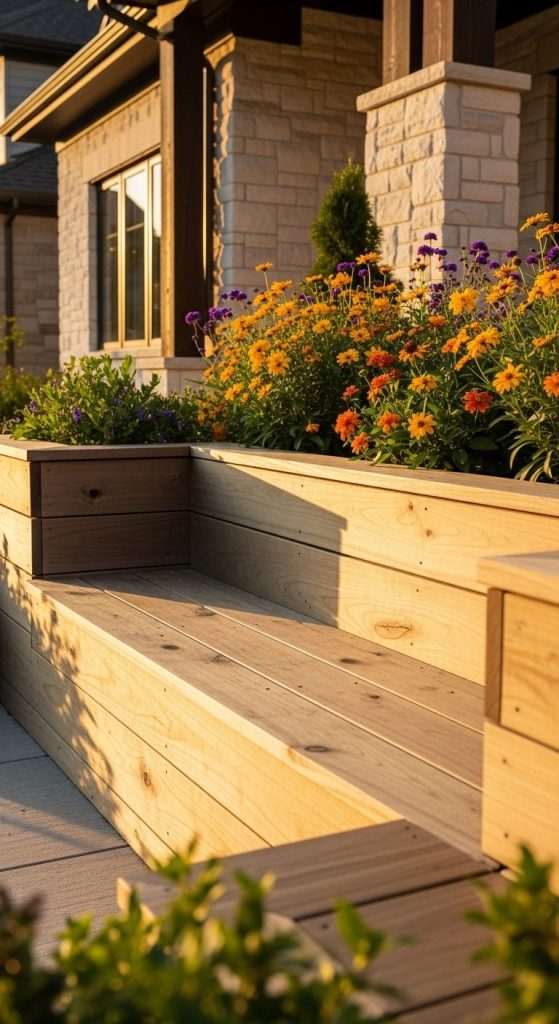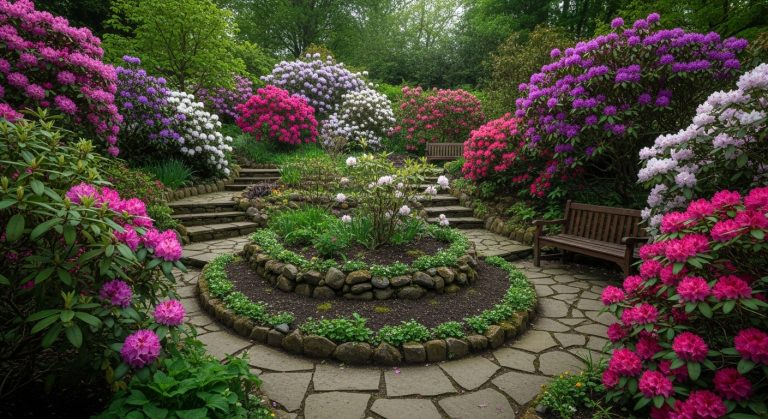Raised Garden Beds Landscaping: 15 Brilliant Ideas to Transform Your Outdoor Space
Ever thought about giving your garden a timeless, organized, and downright stunning makeover without breaking the bank? Well, raised garden beds landscaping might be your new favorite weekend obsession. Whether you’re a casual gardener or someone who lives for those quiet early mornings with a cup of coffee and a trowel, raised beds can elevate (pun totally intended) your outdoor experience — literally and visually.
I’ve experimented with almost every kind of garden setup over the years — from messy ground-level patches to perfectly structured raised beds — and trust me, nothing beats the beauty and functionality that raised garden beds bring. They’re neat, easier to maintain, and let’s be honest, they make your backyard look like something straight off Pinterest.
So, grab your gloves, and let’s get into 15 creative ideas for raised garden beds landscaping that’ll make your outdoor space more functional, beautiful, and totally you.
1. The Classic Wooden Frame Design

Wooden raised garden beds are timeless. They’re simple, elegant, and blend effortlessly with almost any landscape style — whether you’re going for rustic farmhouse vibes or a modern minimalist look.
Pros:
- Easy to build and customize.
- Natural wood tones complement plants beautifully.
- Affordable and eco-friendly (especially if you use reclaimed lumber).
Cons:
- Wood can rot over time unless treated or sealed.
- Needs maintenance every few seasons.
Personal Tip: I always use cedar because it’s naturally rot-resistant and smells amazing after rain. If you’re planning a vegetable garden, untreated wood is best for safety.
2. Stone Raised Beds for a Natural Aesthetic

If you want something durable and earthy, stone raised garden beds are unbeatable. They look fantastic in any landscape and create a permanent structure that adds value to your home.
Pros:
- Long-lasting and low-maintenance.
- Retains heat well, helping early growth.
- Perfect for sloped or uneven yards.
Cons:
- Labor-intensive to build.
- Can be expensive depending on the stone type.
Did you know? According to Houzz, natural stone features can increase property value by up to 15% — not a bad excuse to stack a few rocks, right?
3. Metal Beds with Modern Charm

Metal raised garden beds have become the darling of modern landscaping. They’re sleek, sturdy, and come in powder-coated finishes that can last for decades.
Pros:
- Extremely durable and weather-resistant.
- Adds a clean, industrial edge to your yard.
- Reflects heat for faster soil warming.
Cons:
- Can get hot in extreme sun.
- Usually pricier than wood options.
Pro Tip: Go for galvanized steel — it doesn’t rust easily and gives your garden a crisp, professional look.
4. Tiered Raised Beds for Sloped Landscapes

Have a sloped yard that’s a nightmare to plant in? Tiered raised beds can turn that tricky space into a cascading green masterpiece.
Pros:
- Ideal for uneven landscapes.
- Allows creative planting layers (flowers up top, veggies below).
- Adds architectural interest.
Cons:
- Requires planning and solid structural support.
- Slightly more complex to build.
FYI: A well-designed tiered garden not only saves space but also helps with drainage — no more waterlogged roots!
5. U-Shaped Raised Garden Beds for Easy Access

If bending over or reaching far corners makes gardening feel like a workout, U-shaped raised garden beds are your best friend. They’re practical and super ergonomic.
Pros:
- Maximum reach with minimal effort.
- Great for older gardeners or limited mobility.
- Visually appealing and symmetrical.
Cons:
- Takes up more space than traditional rectangular beds.
- Slightly more material needed.
I built mine last spring, and it completely changed my gardening rhythm — no more stepping into beds or compacting soil. Total game-changer!
6. Brick Beds for a Timeless Touch

Brick raised garden beds combine elegance and endurance. They give your yard that “English cottage” charm while being incredibly sturdy.
Pros:
- Durable and weather-resistant.
- Classic design that suits traditional homes.
- Retains warmth for heat-loving plants.
Cons:
- Labor-intensive installation.
- Slightly costlier than wood.
Fun Fact: Bricks can last over 100 years, meaning your raised bed might outlive your shovel.
7. Raised Herb Beds for Kitchen Lovers

Imagine walking out to snip fresh basil or rosemary straight from your own raised herb bed — culinary heaven, right? These compact gardens are both beautiful and functional.
Pros:
- Perfect for small spaces or patios.
- Fresh herbs year-round.
- Easy to maintain.
Cons:
- Herbs need frequent harvesting.
- Some herbs can spread quickly.
Pair this setup with a gravel or stone pathway for an Instagram-worthy kitchen garden look.
8. Vertical Layered Beds for Compact Spaces

No room? No problem. Vertical raised garden beds are perfect for urban or small-space gardeners.
Pros:
- Maximizes planting area in minimal space.
- Great for herbs, strawberries, and greens.
- Visually striking.
Cons:
- Requires good irrigation.
- Limited plant depth.
Statistic: According to Statista, urban gardening grew by over 30% in 2023, and vertical beds are leading the charge. Perfect for balconies or narrow yards.
9. Corner Raised Garden Beds for Space Optimization

Corners are often underused in landscaping. With a clever corner raised bed, you can add symmetry and purpose to those forgotten spaces.
Pros:
- Excellent for small or irregular yards.
- Adds a polished, complete look to the landscape.
- Flexible design options.
Cons:
- Limited expansion space.
- May require custom fitting.
Try mixing corner beds with tall ornamental grasses or flowers to soften hard landscape lines.
10. Raised Flower Beds for Aesthetic Drama

If veggies aren’t your thing, raised flower beds create a colorful focal point that instantly brightens any landscape.
Pros:
- Easy maintenance and weed control.
- Ideal for seasonal blooms.
- Enhances curb appeal.
Cons:
- Requires replanting per season.
- Some flowers need consistent fertilizing.
IMO, there’s nothing quite like the pop of marigolds, lavender, and petunias spilling over a rustic wooden frame.
11. Concrete Block Raised Beds for Durability

Concrete blocks (aka cinder blocks) are the unsung heroes of raised garden beds landscaping. They’re cheap, durable, and endlessly customizable.
Pros:
- Affordable and readily available.
- Long-lasting with minimal upkeep.
- Easy to stack and shape.
Cons:
- Heavy to move.
- Can look plain unless painted or decorated.
Pro Tip: Plant succulents or small herbs in the block holes for a stylish twist.
12. Mixed Material Designs for Creative Landscapes

Why stick to one material when you can mix it up? Combining wood, stone, and metal gives your raised garden beds a designer edge.
Pros:
- Unique and customizable aesthetics.
- Balances natural and modern textures.
- Great for large landscapes.
Cons:
- Requires planning to balance materials.
- May cost more initially.
Mixing stone sides with wooden trims adds both warmth and structure — a perfect balance between rustic and refined.
13. Raised Beds with Built-In Seating

Want to blend relaxation and gardening? Add a wooden bench or stone ledge around your raised beds. It’s functional and stylish.
Pros:
- Dual-purpose: seating and gardening.
- Perfect for social garden spaces.
- Enhances landscape design.
Cons:
- Needs sturdy support.
- Might limit bed space.
This setup works wonders for entertaining. Picture sipping tea while surrounded by your blooms — pure serenity.
14. Raised Garden Beds with Irrigation Systems

Tired of watering every day? Integrate a drip irrigation system into your raised beds to keep plants hydrated efficiently.
Pros:
- Saves time and water.
- Ensures consistent soil moisture.
- Great for large gardens.
Cons:
- Requires initial setup.
- Tubing can look messy if not hidden.
According to the EPA, drip irrigation systems use up to 50% less water than traditional watering — your plants (and wallet) will thank you.
15. Raised Garden Beds as Landscape Borders

Here’s an underrated design move — use raised beds as natural borders to define pathways, patios, or lawn edges.
Pros:
- Creates visual separation.
- Adds greenery to walkways.
- Increases landscape harmony.
Cons:
- Requires precise measurement.
- Can restrict walkway width.
Design Hack: Line your pathways with low-growing plants like lavender or creeping thyme for a fragrant, polished look.
Conclusion
At the end of the day, raised garden beds landscaping is about creativity and practicality coming together. Whether you’re working with wood, stone, or steel, each material tells a story — one that blends function with flair. The key is to design something that suits your lifestyle, your space, and your vibe.
Gardening, after all, isn’t just about growing plants — it’s about growing peace, joy, and a little bit of pride every time you look out your window.
So, what’s stopping you? Grab those gloves and start building your dream raised garden bed landscape today.

Ashley Ellison is a skilled writer and avid bowler. Her passion for storytelling and dedication to the sport have led her to participate in various national bowling leagues. With a unique combination of talents, Ashley approaches every challenge with creativity and a relentless drive to succeed.






